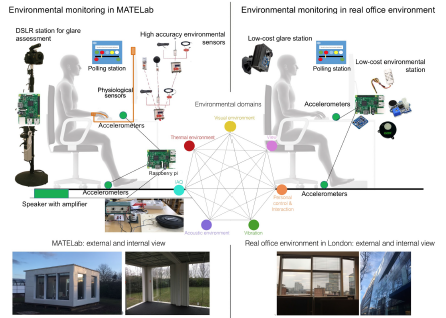The principal novel aspect of this research project is the creation of a ‘toolkit’ of digital sensors and other methods for capturing overall occupant response in terms of comfort, satisfaction, productivity and well‐being. The toolkit consists of a range of existing sensors and additional devices that together capture the wide effects of novel resource‐efficient technologies, such as the user responses to automatic façade systems and the effects of material‐efficient structures on occupant productivity and well‐ being.
Future cities will generate an unprecedented demand for resource-efficient, healthy and productive buildings that cater for an additional 2.5 billion urban inhabitants by 2050 and simultaneously mitigate the impact of climate change. Dynamic building components and controls have the potential to shape novel responsive and resource-efficient environments that meet actual occupant demands. A major barrier to the uptake of dynamic technologies in buildings is that the transient effects on occupant satisfaction are poorly understood, in particular there is a paucity of methodologies for capturing and assessing transient effects on occupant satisfaction, productivity and wellbeing. This report is the outcome of a research mini-project called “Building impulse”, The project, funded by the Centre for Digital Built Britain, aims to assemble and develop a Building Impulse Toolkit (BIT), which is a novel array of digital sensors and other methods for capturing overall occupant response in terms of comfort, satisfaction, productivity and well‐being.
BIT will provide a means of establishing quantitative relationships between transient changes in environmental characteristics and overall occupant satisfaction and productivity. The toolkit consists of a range of existing sensors and additional devices that together capture the wide effects of novel resource-efficient technologies, such as the occupant responses to dynamic façade systems and the effects of material-efficient structures on occupant productivity and well-being. The Toolkit addresses three fundamental aspects: Environmental monitoring; Unobtrusive systems for continuous occupant feedback Indirect systems for capturing occupant preferences. All three aspects of BIT were considered carefully in the development of the first prototypes of they will be tested in real-world offices in London and in a novel office-like test facility, called MATELab (Mobile Adaptive Technology Experimental Lab) at the University of Cambridge. A full quantitative assessment of BIT, has yet to be performed (and is expected to be completed by June 2018), but this mini-project provides a qualitative insight on the following important features of the novel toolkit: (i) unobtrusiveness of the system, (ii) accuracy of the data collected and (iii) potential further implementation and limits.

Environmental domains and their inter-effects considered for Building Impulse
BIT captures the holistic and transient relationship between environmental conditions and occupant response and is essential for developing the next generation of intelligent, adaptable and user-centred buildings. Data from BIT should allow us to control novel building technologies in a far more effective and evidence-based manner. For example, it would be possible to: (i) devise control strategies for switchable glazing that reduce energy demand and simultaneously respond occupants’ reactions to these dynamic changes and;(ii) reduce the mass of a building frame without compromising safety, by accounting for occupants’ response to deformations / vibrations. In the absence of this holistic measure of occupant comfort and satisfaction, the use of resource‐ efficient measures and technologies can (and often do) result in dissatisfaction or discomfort for occupants. BIT is not limited to future building. Indeed, several existing buildings could benefit from a low cost toolkit for informing possible improvements in their performance, particularly in occupant satisfaction and wellbeing.
Researcher:
Dr Mauro Overend
Department of Engineering, University of Cambridge
Dr. John Orr
Department of Engineering, University of Cambridge
Prof. Tim Ibell,
Department of Engineering, University of Cambridge
Dr James Talbot,
Department of Engineering, University of Cambridge
Alessandra Luna Navarro
Department of Engineering, University of Cambridge
Mark Allen
Department of Engineering, University of Cambridge
Cambridge Centre for Smart Infrastructure and Construction
Alistair Law,
Arup
